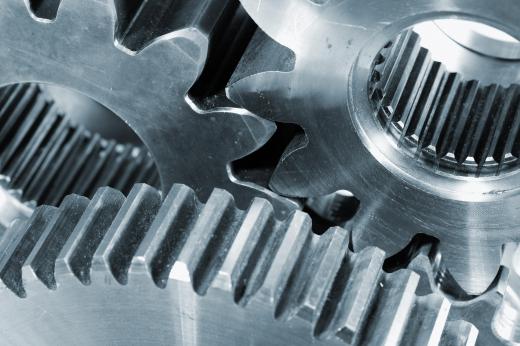A gear calculator is a device used to determine gear ratio for a variety of purposes and in a variety of applications. Uses for gears include changing the direction of rotation, increasing or decreasing rotational speed, transferring rotational motion to a different axis, and synchronizing rotation of two different axes. Machines from grandfather clocks to bicycles and motor vehicles depend on gears for efficient and accurate operation. A gear calculator is generally necessary to determine appropriate gear size and configuration.
Gears are essentially wheels on an axle, and may interact through friction, connecting belts, or teeth. To prevent possible slippage, resulting in inefficiency and inaccuracy, most gears are designed to interface with teeth that must be identical in dimension on both interacting gears. Using toothed gears permits accuracy in calculating rotation speeds while allowing for slight differences in gear diameter.

A gear calculator applied to toothed gears need only record and compare the number of teeth on the respective gears to arrive at an accurate gear ratio. If a larger gear has 60 teeth and a smaller gear has 20 teeth of the same size, the ratio is described as 3:1, or three to one. This means that the smaller gear will rotate three times for every rotation of the larger gear.
In an automobile or truck, the transmission and differential gear ratios determine the most efficient tire size for use on a particular vehicle. The tire is essentially the final “gear” supplied with rotational force in the automotive propulsion train. If a tire larger than the size recommended is installed, the speed of the vehicle might be greater due to a greater diameter, but greater power demands will be made on the engine through the leverage of the gears, potentially damaging the drive train or engine.
When tires are installed on a vehicle that differ from a manufacturer’s recommendation, the miles-per-hour (MPH) or kilometers-per-hour (KPH) indicated on the speedometer will not be accurate. The speedometer is calibrated for the revolutions per minute (rpm) of a recommended tire size. If a larger tire is installed, the true speed of the vehicle will be greater than the speed as seen on the speedometer, with the potential to exceed legal speed limits. A gear calculator may easily be found online that will calculate the variations in speed with changes in tire size.
Bicycle riders are extremely sensitive to gear ratio differences because they are the power source for their bikes. Competitive riders use a gear calculator that will generally include specific data on crank length, tire size, front and rear sprocket dimensions, and chains. In a modern bicycle, it is not unusual to find 18 to 21 combinations of gears used for different power and speed requirements.
